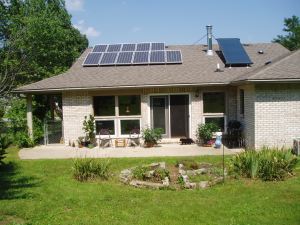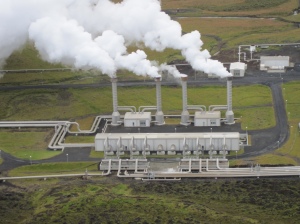Four thousand years ago, ancient Egyptians built ships with sails made from papyrus reeds, allowing them to harness the power of the wind to float down the Nile. They were using a form of renewable energy. Human beings have been doing something similar ever since.
Renewable energy – hydroelectric, biomass, geothermal, solar and wind – accounts for about 12 percent of all electricity produced in the U.S. last year. Over the next three years, one third of all new energy added to our nation’s grid will come from these sources.
In a world that continues to rely heavily on dwindling supplies of coal and oil – threatening the existence of the planet itself – the importance of developing renewable sources of energy cannot be overstated. In fact, we face no greater challenge than the environmental unpredictability and extremes that climate change is bringing.
When it comes to renewable energy, even small projects can have a big impact. From supplemental solar heaters helping to save residents in colder climates $100 a month on their heating bills to Google investing millions in Enhanced Geothermal Systems, renewable energy is making a big impact on both a personal and national level.
Last month we focused on the topic of replacing our nation’s crumbling infrastructure. This month we’ll talk about another BIG topic: how to harness the power of the wind, the sun, and the earth to generate the energy we need to fuel our modern economies.
There is much hype surrounding renewable energy, as well as a lot of misinformation on both sides of the issue. Despite the promise renewable energy holds, many projects fail, due in large part to falsehoods, not facts. A recent study by the International Energy Agency found that many projects fail due to a lack of understanding and acceptance by the general public.
In this blog post we wanted to explore some of the myths behind this big industry. Misinformation about renewable energy is rampant. Perhaps you have heard of these:
MYTH #1: Solar energy is expensive and impractical
According to a 2012 survey by Harris Interactive, nearly all Americans overestimate what it costs to go solar. While installing atypical 5-kilowatt photovoltaic system for a house can cost between $25,000 and $30,000 to install, third-party solar energy companies can reduce the upfront cost to nearly zero.
Many utility companies will rebate up to 50 percent of the cost for residential and commercial property owners that switch to solar, and state and federal tax credits can reduce that cost even further. (Click here to see a list of tax credits and rebates available by state.)
For applications like roadway signage, rural irrigation and remote communications, solar power is becoming the system of choice, thanks to its remarkable cost efficiency.
MYTH #2: Wind turbines are decimating the bird population
It’s true that wind turbines kill an estimated 600,000 birds each year. But they still account for less than 1 out of every 30,000 bird deaths, according to the US Department of Energy, or fewer than are killed by cars, powerlines, windows, and environmental pollution. Turbines are nowhere near as lethal as house cats, which kill as many as 3.7 billion of our feathered friends annually.
MYTH #3: Wind turbines are noisy
Wind turbines are almost never installed less than 300 meters from the nearest house – or more than the length of three football fields. At this distance the turbine produces a sound pressure level of 43 decibels. That’s less than your average air conditioner and about the same as a refrigerator.
MYTH #4: Geothermal plants cause pollution
Most images of geothermal plants, which tap into steam heat trapped beneath the earth’s surface and convert it into energy, show thick white plumes pouring from “smoke stacks.” Some people see that and assume it’s smoke, a byproduct of combustion. In reality, the emissions from water-cooled geothermal power plants are water vapor, not smoke.
MYTH #5: Renewable energy provides a tiny fraction of our electricity
As noted earlier, roughly one out of eight kilowatts of energy in this country is generated from renewable sources. Looking at this on a global scale, however, the numbers are more impressive. The United States generates 20 of the world’s electricity. That means that US wind power alone exceeds the power output of entire countries as large as Australia and Switzerland.
MYTH #6: Mitigating climate change is too expensive
Nearly all scientists agree that climate change is real and getting worse. As carbon emissions clog our atmosphere, the ice caps melt, and average temperatures rise, the need for more energy to control the temperatures in our homes and businesses increases, creating a vicious cycle. According to the EPA, a 6 to 9 percent increase in average temperatures would increase our need for electricity by 10 to 20 percent.
Keeping up with the demand would require hundreds of billions of dollars in additional infrastructure investments. Avoiding the challenges posed by global climate change is ultimately more costly than dealing with them.
Communicating the effects of climate change and benefits of renewable energy is a big challenge. Making the connection between the carbon cycle, global warming, and the need for renewable energy sources and the amount of your monthly electric bill is daunting concept for many to grasp. Having factual and easily accessible information about renewable energy is almost as important as securing these sources of energy.
Over the next four weeks, we’re going to examine a variety of renewable energy projects – from large ambitious endeavors to smaller but innovative solutions. More importantly, we’ll talk about effective communications strategies that can help guide the conversation about these projects. We hope you join us as we cast off and explore these ancient power sources.
The Collaborative Services Team







Recent Comments